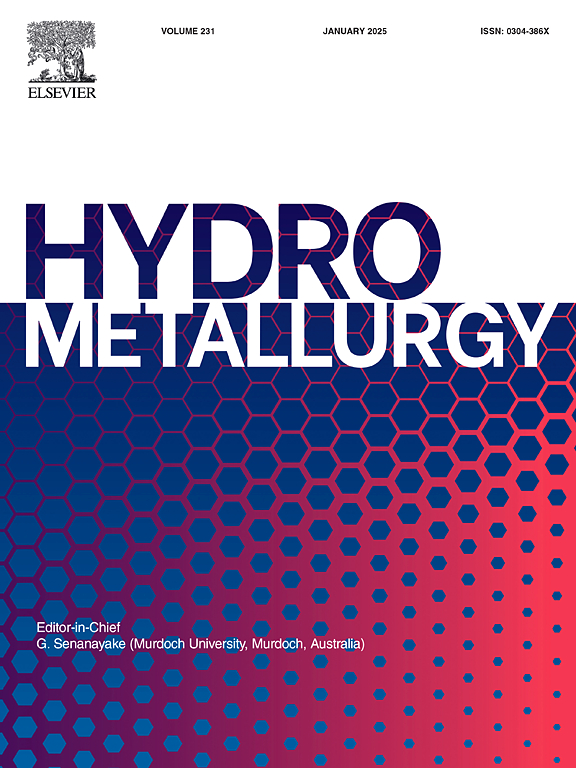在二甲苯中使用双功能离子液体 [A336][Cy272]从钼矿精矿的高压釜酸浸液中分离铼和钼
IF 4.8
2区 材料科学
Q1 METALLURGY & METALLURGICAL ENGINEERING
引用次数: 0
摘要
双功能离子液体(bibi - ils)是一类阳离子和阴离子通过化学键积极参与萃取过程的液体。这些液体具有高选择性和稳定性。本文研究了用二甲苯稀释的bibi - il [A336][Cy272]溶剂萃取钼(Mo)和铼(Re)。各种参数,如搅拌速度,温度,水与有机(A/O)相体积比,接触时间,酸浓度和萃取剂浓度,检查以确定其影响钼的提取复苏和分离系数和再保险。最高的Re / Mo分离系数(SFRe / Mo = 114)和重新提取的比例最高(91%)实现从浸出解决方案包含∼5.5 g L−1 Mo和6.6×10−2 g L−1再保险。这些结果在优化条件下:[A336] [Cy272]在2.5% (v / v)在有机相,pH = 0.35, a / O = 1/1,接触时间= 10分钟,温度和搅拌速度= 300 rpm, = 298 K。采用斜率分析方法对Mo和Re的萃取机理进行了研究,结果表明萃取过程遵循离子缔合机制。当施加1 M (NH4)2CO3时,Re在水相中的溶出效率较高。在实验条件下,稀土的溶出率为99.7%,而钼和其他杂质的溶出率可以忽略不计。本文章由计算机程序翻译,如有差异,请以英文原文为准。
Separation of rhenium and molybdenum from autoclave acid-leach liquor of molybdenite concentrate using bifunctional ionic liquid [A336][Cy272] in xylene
Bifunctional ionic liquids (Bif-ILs) are a class of liquids in which both cations and anions actively participate in the extraction process through chemical bonds. These liquids exhibit high selectivity and stability. This study investigated the solvent extraction of molybdenum (Mo) and rhenium (Re) using the Bif-IL [A336][Cy272], diluted in xylene. Various parameters, such as stirring speed, temperature, aqueous-to-organic (A/O) phase volume ratio, contact time, acid concentration and extractant concentration, were examined to determine their effects on the extraction recovery and separation factor of Mo and Re. The highest Re/Mo separation factor (SFRe/Mo = 114) and the highest percentage of Re extraction (91 %) were achieved from a leach solution containing ∼5.5 g L−1 Mo and 6.6 × 10−2 g L−1 Re. These results were obtained under optimized conditions: [A336][Cy272] at 2.5 % (v/v) in the organic phase, pH = 0.35, A/O = 1/1, contact time = 10 min, stirring speed = 300 rpm, and temperature = 298 K. The extraction mechanism for Mo and Re was studied using the slope analysis method, which revealed that the process follows an ion-association mechanism. The Re stripping into the aqueous phase was efficient when 1 M (NH4)2CO3 was applied. The Re stripping efficiency under the examined conditions was 99.7 %, while the stripping of Mo and other impurities was negligible.
求助全文
通过发布文献求助,成功后即可免费获取论文全文。
去求助
来源期刊

Hydrometallurgy
工程技术-冶金工程
CiteScore
9.50
自引率
6.40%
发文量
144
审稿时长
3.4 months
期刊介绍:
Hydrometallurgy aims to compile studies on novel processes, process design, chemistry, modelling, control, economics and interfaces between unit operations, and to provide a forum for discussions on case histories and operational difficulties.
Topics covered include: leaching of metal values by chemical reagents or bacterial action at ambient or elevated pressures and temperatures; separation of solids from leach liquors; removal of impurities and recovery of metal values by precipitation, ion exchange, solvent extraction, gaseous reduction, cementation, electro-winning and electro-refining; pre-treatment of ores by roasting or chemical treatments such as halogenation or reduction; recycling of reagents and treatment of effluents.
 求助内容:
求助内容: 应助结果提醒方式:
应助结果提醒方式:


